-
Posts
148 -
Joined
-
Last visited
Content Type
Profiles
Forums
Events
Posts posted by Apwu133
-
-
-
 TSP participants affected by COVID-19 (as defined by the CARES Act, P.L. 116-136) may now apply for a TSP general purpose loan with an increased maximum loan amount. These participants may also temporarily suspend payments on TSP loans they currently have and on loans taken between now and November 30, 2020. The deadline for applying for a loan with an increased maximum is September 18, 2020. The deadline for requesting suspension of loan payments is November 30, 2020. Loan payment suspensions will last for the rest of calendar year 2020.
TSP participants affected by COVID-19 (as defined by the CARES Act, P.L. 116-136) may now apply for a TSP general purpose loan with an increased maximum loan amount. These participants may also temporarily suspend payments on TSP loans they currently have and on loans taken between now and November 30, 2020. The deadline for applying for a loan with an increased maximum is September 18, 2020. The deadline for requesting suspension of loan payments is November 30, 2020. Loan payment suspensions will last for the rest of calendar year 2020.You are subscribed to TSP Plan News for Thrift Savings Plan. This information has recently been updated, and is now available.

-

APWU Health Plan COVID-19 Coverage EnhancementsAs we work together to slow down the spread of COVID 19, our lives continue to evolve and change in ways we could have never expected. The APWU Health Plan will continue to evaluate coverage enhancements as a result of COVID-19. Because the spread of the virus has slowed down considerably, we are removing the inpatient prior authorization wavier. Initially, the Health Plan wanted to remove this administrative burden as hospitals were overwhelmed. As we get back to the new “normal,” authorizations should be obtained.
For the most up-to-date information visit our website
at www.apwuhp.com/coronavirus-outbreak-update /The Health Plan will:
-
Cover telehealth (medical and mental health) visits at no cost* to the member when visits are performed through the Health Plan’s telehealth providers:
- High Option: Medical visits through Amwell are available at www.amwell.com and mental health visits through MDlive are available at www.mdlive/apwu at no cost* to the member
- Consumer Driven Option: Virtual visits through AmWell, Teladoc, and Doc on Demand are available at www.myuhc.com at no cost* to the member
- Cover telehealth visits to network providers at no cost* to the member when related to COVID-19
- Cover COVID-19 testing at no cost* to the member when testing is prescribed by a clinical professional including antibody testing once it becomes widely available
- Cover health care provider office visits, urgent care center visits and emergency room visits that result in an order for or administration of a diagnostic test for COVID-19 at no cost* to the member**
- Cover in-network inpatient and outpatient care for COVID-19 treatment at no cost* to the member
- Reminder: Members are encouraged to use mail order form maintenance medications which provides a 90-day refill and the delivery is free
*All deductible, coinsurance and copays will be waived
**Your provider should be aware of this Families First Coronavirus Response Act and CDC guideline. If you are charged a copay or coinsurance at the time of your visit, you will be reimbursed -
-
 The CARES Act allows us to offer temporary loan and withdrawal options to TSP participants affected by COVID-19. We are working as quickly as possible to add these options to our system so you can count on efficient processing of these requests. You can check this webpage for updates about these options and when they will be available to you. We will post the next update by May 15, 2020.
The CARES Act allows us to offer temporary loan and withdrawal options to TSP participants affected by COVID-19. We are working as quickly as possible to add these options to our system so you can count on efficient processing of these requests. You can check this webpage for updates about these options and when they will be available to you. We will post the next update by May 15, 2020.
-

Our number one priority during the Coronavirus pandemic is keeping members safe.
It’s clear that the White House is withholding the funding that the USPS needs for safe and sustainable operations during this crisis.
It’s so clear that the crisis at the Postal Service has now hit the headlines. Congress needs to hear from you!
The White House refused relief for the Postal Service in the last stimulus and Congress left us out of the bill.
Without immediate relief, the Postal Service could run out of cash by summer.
Our jobs, our pensions and the vital service we provide is at risk.
Big corporations are lobbying against the Postal Service because they want to boost their profits. We need to make sure that Congress hears us instead.
That’s why you need to send a message to Congress.
Congress needs to provide urgent funding in the next stimulus for the Postal Service to keep the country moving through the crisis. Everything is on the line and your voice can make the difference.
Send them a message today: Tell them to provide the resources we need!
In solidarity,
American Postal Workers Union
-
The APWU Health Plan will continue to evaluate benefit enhancements as a result of COVID-19. For the most up-to-date information visit our website at
www.apwuhp.com/coronavirus-
outbreak-update/ The Health Plan will:
-
New! Cover health care provider office visits, urgent care center visits and emergency room visits that result in an order for or administration of a diagnostic test for COVID-19 at no cost* to the member**
-
Cover COVID-19 testing at no cost* to the member when testing is prescribed by a clinical professional
-
Cover telehealth visits at no cost* to member when visits are performed through the Health Plan’s telehealth providers:
-
High Option: Visits through Amwell are available at www.amwell.com at no cost* to the member
-
Consumer Driven Option: Virtual visits through AmWell, Teladoc, and Doc on Demand are available at www.myuhc.com at no cost* to the member
-
-
Cover telehealth visits to network providers at no cost* to member when related to COVID-19
-
Waive inpatient prior authorization requirements related to COVID-19
-
Reminder: Members are encouraged to use mail order for maintenance medications which provides a 90-day refill and the delivery is free
*All deductible, coinsurance and copays will be waived
**Your provider should be aware of this Families First Coronavirus Response Act and CDC guideline. If you are charged a copay or coinsurance at the time of your visit, you will be reimbursed by the Health Plan -
-
The Postal Service has informed the APWU of the date that Postal Support Employees (PSEs) who have been employed in 125 workyear or larger offices for more than 2.5 years (30 months) will be converted to career status. Over 2,500 current PSEs will be converted on May 9, 2020, the beginning of pay period 11.
These conversions are consistent with the Interest Arbitration panel’s award issued on March 10, 2020. Conversions of PSEs was one of the demands your negotiators made from the very start of negotiations.
“Being able to achieve career status for PSEs was an important goal for us,” President Mark Dimondstein said. “These newly converted employees will see an immediate pay increase, an increase in benefits paid for by the Postal Service, guaranteed work hours, and in most cases fixed schedules.”
As a reminder, as newly converted career employees, these PSEs will have sixty-days (60) from May 9, 2020 (July 8, 2020), to make benefit decisions. New career employees may choose new health insurance plans, enroll in the Federal Employee Group Life Insurance (FEGLI) plan, choose how much to contribute to the Thrift Savings Plan (TSP), where to allocate TSP funds, and other benefits decisions. The Postal Service is supposed to send each newly converted employee a “benefits” book with all the necessary forms and instructions for making these extremely important decisions. The sixty-day limit is a hard limit and cannot be extended. Employees are encouraged to begin looking at their new benefits and not wait until the very end of the 60 days to decide.
“The importance of these conversions cannot be overstated,” Clerk Craft Director Lamont Brooks said. “This isn’t the end of our battle for more career employees. We are proud that the APWU did not see an increase in the allowable usage of non-career employees in our new contract and we will continue to fight for what is right — an all-career workforce.”
-
Under the new 2018 – 2021 National Agreement, employees will receive four retroactive pay raises. The current rates went into effect on February 29, 2020 and will be reflected for the first time in earnings for Pay Period 09-2020. Pay Period 09 begins Saturday, April 11. Pay checks will be dated for May 1, 2020. Retro pay covering the period from September 24, 2018 through April 10, 2020 will follow.
The Postal Service has yet to confirm a date that employees will receive retroactive pay. Recently passed laws regarding the COVID-19 pandemic providing new and additional benefits to employees require immediate and extensive programming and have delayed the Postal Service’s confirmation of the date.
WHAT IF I AM NO LONGER WORKING AT USPS OR IN AN APWU BARGAINING UNIT?
Employees who worked during the retroactive period will be paid the higher rates due for that work. Workers who transferred, separated, quit, retired, deceased, etc. will be compensated for any time worked when higher rates were due. The higher rates will be reflected in adjustments to TSP, Retirement, terminal leave payments, and life insurance. Retirees will eventually get any necessary adjustments to annuity payments – including retroactive annuity adjustments.
NEW SCHEDULE, NEW STEPS
Employees in the new pay schedule in Grades 5 through 7 could not progress beyond Step J in the last contract. With the new contract, employees in Grade 5 can progress to Step K and those in Grades 6 and 7 can move into steps K and L. Employees in Grade 8 stopped at Step K in the last contract; now they can progress into Steps L and M. The step wait time for all steps for Grades 5 though 7 is 36 weeks. For Grade 8 steps, the wait time is 30 weeks.
Most employees on the new schedule are well below the previous top steps, but about 200 employees are immediately eligible to move into the new steps. Eligible employees will be moved into the higher steps in Pay Period 11, effective May 9. They will move based on time waited in the previous top step. For example, a Grade 6 Step J employee who has been in Step J for 20 weeks would wait another 16 weeks before moving to Step K. Someone who has waited 40 weeks in Step J would move into Step K in PP 11-2020 with 4 weeks of wait time credit for advancement to Step L. An employee with 72 weeks of wait time in Step J would skip Step K and move into Step L in PP 11-2020.
-
Since the early days of the Postal Service, we postal workers have helped stitch the fabric of the country together. Even in times of crisis – whether natural disaster, conflict, or economic calamity – the Postal Service has always been there, steadily reaching every American home and business in their time of need.
Today is a time of crisis unlike any we’ve seen in generations. A global pandemic threatens the health of millions and is leading to an economic collapse that could dwarf the Great Recession.
Hundreds of millions of people are sheltered in their homes, avoiding the grocery, pharmacies and other stores as we attempt to slow the spread of the virus. Many workers will soon be without paychecks. Public health officials are desperate to effectively disseminate health-saving information, tests, and drugs.
The United States Postal Service is critical to the country’s public health and economic stability in this moment. Postal workers are up to the task. Our network of 157 million daily delivery points, 35,000 post offices and more than 500,000 dedicated public servants is uniquely positioned to serve the country in the weeks and months ahead.
The Postal Service is the only way for millions of people to receive their medications. Last year, we delivered over a billion prescriptions. It’s the only way to disseminate stimulus checks and critical public health information and supplies to every household. Vote-by-mail will be essential to holding elections in November. And, in this new era of “social distancing,” it’s still a time- tested way to connect families and friends no matter where they are.
But if the Postal Service is to meet the challenge of the times, two immediate issues need to be resolved:
First, postal workers must have safe workplaces. Our union is working feverishly to ensure the Postal Service provides for the health and safety of our members and the mailing public. We have already secured important changes to leave, staffing and post office policies. We remain concerned that the distribution of personal protective equipment and sanitizers has been uneven across the country.
Every member from the shop floor to the national office must continue our demand that we have safe workplaces, safe staffing and the necessary equipment and supplies to fulfil our mission.
Second, Congress must act immediately to ensure the financial viability of the Postal Service. We were deeply disappointed that stimulus legislation nearing passage Wednesday does not include vital relief for the Postal Service. The economic fallout of the pandemic calls for measures far beyond the prefunding repeal we’ve long sought.
House legislation initially sought in excess of $25 billion in direct relief for the USPS. If Congress does not act soon and on a similar scale, the Postal Service will run out of cash in the coming months. Every member must demand of their representatives that postal relief is included in the next stimulus.
Reports surfaced this week that the White House and Treasury Department oppose cash support for the Postal Service. Their resistance would condemn the country’s most trusted and highest- rated federal agency to its demise. It would destroy the one institution capable of reaching every person, hinder the country’s public health response, and cripple the $1.4 trillion mailing and shipping industry.
Our union had planned to spend much of this month commemorating the 50th anniversary of the Great Postal Strike. Those plans have obviously changed. But let us remember one important lesson the 1970 strike proved: the country relies on the hard work of dedicated postal workers, especially in the toughest of times. I believe our current crisis underscores the value of our work and the universal network we uphold.
Finally, let me conclude by recognizing the extraordinary role postal workers have already played in the throes of this crisis. These are unusual times and many of us are understandably anxious – for ourselves, our families, our jobs and our communities. I, like so many others, am heartened by the extraordinary courage of seemingly ordinary workers serving their neighbors in times of need. Together, let’s support each other, encourage each other, demand safe workplaces together and continue to serve each other in these extraordinary times.
-----------
We constantly update resources available to members at apwu.org/coronavirus
-

I am writing to give you an update on APWU's response to the Coronavirus Pandemic.
As this Coronavirus crisis unfolds, we are in constant discussion with USPS management, demanding temporary leave policies, telework provisions where possible and better safety policies, supplies, and equipment.
One thing is clear. Our very first priority is ensuring that the Postal Service provides for the health and safety of our members.
Postal workers are on the front-lines of the pandemic response. We need to ensure that the hardworking people who keep medicine, medical equipment, food, supplies and other essential goods moving through the mail are protected, as the country relies on us in ways they never have before.
You can find out more at APWU.org/Coronavirus about the policies we have secured from management.
They include:
- A Maintenance Management Order for each post office to increase their cleaning standards (including using cleaning products from before the CTC implementation) and provide gloves, masks, hand sanitizer and sanitizing wipes.
- New Memoranda of Understanding concerning pay, telework and leave include: Temporary Expanded Sick Leave for Dependent Care During COVID-19, Temporary Additional Paid Leave for PSEs, Telework for IT/AS unit, Customer Care Centers, and Mail & Shipping Solutions Center, and HRSSC.
- The newly announced policy of "Liberal Change of Schedule and Leave."
It is important that postal workers come together to help each other.
Please follow the recommended safety procedures, sound the alarm to your local when management has not supplied the necessary equipment or implemented improved cleaning standards, and stay home if you are not feeling well.
We are all in this together.
Read more about our work on Coronavirus at apwu.org/coronavirus.
In Union Solidarity,
Mark Dimondstein
President, APWU -
We Have a New Union Contract!!Read the Full Article#APWUUnited
-
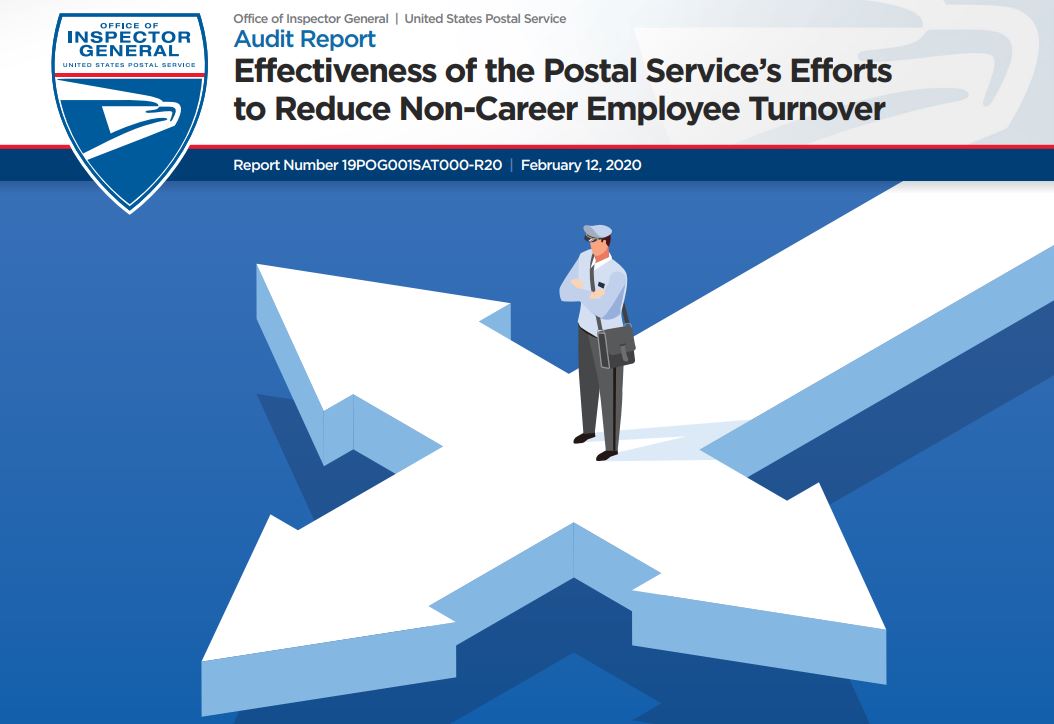
Objective
Our objective was to assess the Postal Service’s effectiveness in reducing non-career employee turnover and evaluate underlying reasons for non-career employee turnover.
The Postal Service hires non-career employees to supplement its regular workforce and reduce staffing costs. Non-career employees are temporary workers who do not receive the same employee benefits as career employees, are not always guaranteed a set schedule, and can work from one to seven days per week. In fiscal year (FY) 2019, the Postal Service had about 136,000 non career employees which represented about 21 percent of its 633,000 employees.
The Postal Service has four non-career employee labor designations or crafts:
■ Mail handler assistant position — unloads and moves mail in plants.
■ Postal support employee position — processes mail and sells postage at post offices.
■ City carrier assistant position — delivers mail on designated city routes.
■ Rural carrier associate position — delivers mail on rural routes.
The Postal Service establishes a non-career employee turnover goal as part of its annual National Performance Assessment (NPA). This goal is used to measure non-career employee turnover to help reduce the Postal Service’s cost of training non-career employees. In FY 2019, the goal was 34.08 percent.
We conducted site visits at 14 district offices, 12 post offices, and two processing and distribution centers (P&DC). These visits represented all seven Postal Service areas and included sites with higher and lower unemployment and non-career employee turnover rates.
Findings
Over the last four years, Postal Service Human Resources Headquarters (HR‑HQ) management took actions to reduce non-career employee turnover. Although the annual turnover decreased from 42.8 percent in FY 2016 to 38.5 percent in FY 2019, it still exceeded the NPA goal of 34.8 percent in FY 2016 and 34.08 percent in FY 2019. Also, the FY 2019 turnover rate exceeded the FYs 2017 and 2018 rates. In FY 2019, the city carrier assistant positions had the highest turnover at 45.8 percent while the postal support employee positions had the lowest turnover at 34.4 percent.
To meet the FYs 2018 and 2019 34.08 percent NPA non-career employee turnover goals, the Postal Service would have had to retain almost 3,000 more non‑career employees in FY 2018 and almost 5,900 more non‑career employees in FY 2019. We calculated this would have reduced the cost of onboarding and training by about $4.1 million in FY 2018 and about $9.6 million in FY 2019 based on management’s estimate of total onboarding and training costs.
Management estimated the Postal Service saved about $8 billion in labor cost from FYs 2016 to 2019 by employing non-career employees. However, they did not measure the cost savings associated with the NPA non-career employee turnover performance. On average in FY 2019, non-career employees who left, worked for the Postal Service for about 81 days. Measuring the potential cost savings associated with reducing non-career employee turnover would help ensure management focuses on improvement.
Also, non-career employee turnover could be improved if HR-HQ management developed a single comprehensive strategic plan for recruiting, hiring, and retaining non-career employees. HR-HQ management developed individual strategies to assist in non-career employee retention at the local level. The strategies included developing engagement training for all employees and revising onboarding training to better address the needs of new non‑career employees.
However, during our site visits, we found inconsistent application of HR‑HQ strategies. Specifically, at seven of the 14 district offices and four of the 14 facilities we visited, management said they had not received training on retaining non-career employees.
Because HR-HQ management did not develop a single comprehensive national strategic plan for recruiting, hiring, and retaining non-career employees of all four crafts, districts developed local strategies to help reduce non-career employee turnover. We found the following examples of local strategies at the 14 districts we visited to help reduce turnover.
- At 11 district offices, management said they required managers to obtain district office approval prior to terminating non-career employees. They did this to ensure non-career employees received performance feedback and were allowed an opportunity to improve their performance before being terminated.
- One district office created managerial policies and procedures for onboarding and training non-career employees. The managers were required to certify completion of the procedures.
- One district office required managers to personally greet new non-career employees, take them on a tour of the facility, and introduce them to other staff when they arrived at the facility.
- One district office provided refresher training to all non-career employees after their first 60 days on the job.
These strategies could be incorporated into a comprehensive strategic plan for all districts to follow.
We also found that HR-HQ personnel e-mailed a voluntary exit survey to non‑career employees who left the Postal Service and made summary results available to local management with access to the Postal Service’s information technology network. From FY 2016 to June 30, 2019, about 28 percent of the non-career employees responded to the exit survey. In FY 2016, the survey’s top two reasons for non-career employees leaving the Postal Service were “Lack of Schedule Flexibility” and “Physical Demands”. From FY 2017 to June 30, 2019, the top two reasons were “Lack of Schedule Flexibility” and “Didn’t Like Supervisor”.
Management at 10 of the 14 district offices we visited were aware of the voluntary non-career employee exit survey and six of the 10 district offices said they used the results to improve non-career employee turnover. However, they were not provided any guidance on how to use the data. We also found that six district offices said they performed their own exit surveys.
HR-HQ management said they monitored the reasons for non-career employees leaving the Postal Service and used the data to deploy strategies to address them. However, they had not established any nationwide processes to ensure non-career employee exit survey results were reviewed by district office personnel and appropriate corrective action plans were developed. Establishing a nationwide policy on use of this exit survey information would better enable effective and consistent actions to address non-career employee turnover.
A comprehensive national strategic plan and procedures would help ensure management consistently focuses on reducing non-career employee turnover, provides better oversight, and ensures best practices and feedback is shared.
Recommendations
We recommended HQ-HR management:
- Measure the cost savings associated with the NPA non-career employee turnover performance.
- Develop a comprehensive non-career employee national turnover strategic plan and procedures to provide more effective management oversight. The plan and procedures should focus on achieving measurable results to reduce non-career employee turnover at the local level by developing action plans to address exit survey results and implement district best practices nationwide.
Read full report
Source: USPS Office of Inspector General -
On Feb. 25, postal workers and the communities we serve are standing up for our public Postal Service. It's time to protect America's most cherished institution.
The House of Representatives has overwhelmingly passed the USPS Fairness Act. Now let's get it through the Senate. We are telling our Senators to pass the Senate companion bill, S.2965.
In 2006, Congress saddled our public Postal Service with an unfair and unsustainable burden of pre-funding retiree health care benefits for the next 75 years! That means paying now for USPS workers who aren't even born yet.
The USPS Fairness Act will start to put that right by removing the unfair burden. By repealing the prefunding mandate, the Postal Service would then be able to focus on investing and innovating services in order to better meet its mission to service every American household and business.
Join us supporting our public Postal Service. Sign up to call your Senators to support S.2965 on Feb. 25, 2020.
-
-
-
On Thursday, Oct. 31 the APWU conducted the installation of the newly elected national officers with a message of unity and determination to fight for the future of postal workers and working people everywhere.

Secretary Treasurer Elizabeth "Liz" Powell Presided The night’s theme was “Moving Forward Together” and the ceremony was presided over by APWU Secretary Treasurer Elizabeth “Liz” Powell.
The guest of honor at the ceremony was AFL-CIO Executive Vice President Tefere Gebre who administered the oath of office.
After an introduction by Executive Vice-President Debby Szeredy, Gebre addressed the gathering, praising the work of APWU’s officers and leadership, “Your union, led by your president, Mark Dimondstein, has been a leader in our movement with the creation of a A Grand Alliance to Save our Public Postal Service, the successful fight to Stop Staples, the campaign to expand the role of the Postal Service, including vote by mail and postal banking -- Fighting to defend the common good, public services and public sector unionism.”
He spoke of the fight during the tough times we face, with working people experiencing cruel and unnecessary hardships with low wages, unsafe workplaces, voter suppression, families ripped apart and refugees turned away.
But he expressed his hope in the face of this adversity:
“…Hope in each of you...serving your communities. Hope in striking teachers. Hope in the 60 million Americans who would join a union today if they could. Hope of a brighter day,” he said.
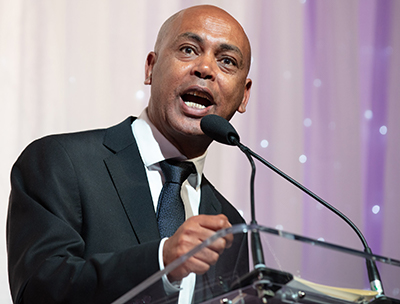
AFL-CIO Executive Vice President Tefere Gebre APWU President Mark Dimondstein gave the keynote speech, congratulating all who were elected and thanking the outgoing officers for their contributions and dedication to the APWU and postal workers. With the union election over he pointed out that, “Now principled unity is key, as we battle corporate greed, Wall Street privatizers, a hostile political environment, and those in management who are undermining the Postal Service.”
After summarizing our substantial progress over the last six years, Dimondstein raised, “But we cannot rest. We are working, living and struggling when there is an all-out war on workers, our families, communities and our organizations. It is Them vs Us, Wall St. vs. Main St., Capital vs. Labor,” he said.
He set out some of the priorities for the coming years: “We will complete the ongoing interest arbitration for a new and good union contract… We will bolster our efforts for new opportunities for postal services, revenue and jobs, including expanding financial services and vote by mail....We will advance the ongoing efforts to gain postal legislation that strengthens the public Postal Service.”

President Dimondstein Gives the Keynote Speech “A new broad union education program is already in the works,” he said and advocated that, “Our Stand Up for Safe Jobs campaign needs deeper roots among the members. And together we must find ways to improve staffing of facilities and address the ever-increasing hostile work environments.”
Most importantly, Dimondstein raised, “The paramount job security battle of our time is to ensure the public Postal Service remains just that. Our jobs, our union and the people’s democratic right enshrined in the Constitution depend on our determination and success. Since the White House plans for full-blown postal privatization emerged, the APWU has mobilized all hands-on deck. With a soon to be new Postmaster General chosen by the Trump-controlled Postal Board of Governors, this critical battle will greatly intensify.”
He encouraged members to, “…attend meetings, join committees, write articles, stand up for safe jobs, sign up non-members, wear union gear with pride, welcome young workers, lobby politicians, fight for postal banking, stand in solidarity with all workers, speak up and defend the public post office.”
He ended with the call to action, “…We must carry on the crusade to save the public Postal Service and our collective bargaining rights and to take on corporate Wall Street power with more workers’ power! Let’s continue to stand up and fight back, hand in hand with each other, all crafts, active, retiree and auxiliary members, postal and other unions, community allies and the people who support the public post office and trust postal workers.”

APWU National Officers Say the Oath of Office -
-
-
-
Per the rules and regulations governing the 2019 APWU National Election, candidates’ statements have been updated to include any new information and/or new submissions submitted by the September 1, 2019 deadline.
Statements by candidates for national union office are posted on www.apwu.org in accordance with Article 11.3.c.2 of the APWU Constitution. To view the statements click here and follow the log-in instructions for the Members Only section.
-
-
On September 15, big changes are coming to your Thrift Savings Plan withdrawal options. You’ll be gaining options of how and when you can access money from your TSP account. TSP breaks it down here:
Flexible Withdrawals Begin September 2019 Current Rules You can customize your installment payments and change your payment frequency at any time as your needs change. You can choose among monthly, quarterly, and annual installment options. Requests to change monthly installment amounts can only be made once each year during a designated open season. You never have to make a full withdrawal election. When you need to make IRS-mandated required minimum distributions (RMDs) at age 70 and after, we'll automatically send you the right amount if you don't withdraw enough during the year. A full withdrawal election is require-d the year you are separated and 70 years older, or your account becomes abandoned. You'll request withdrawals easily using fast and secure online tools by logging into My Account on tsp.gov. Paper forms must be submitted by mail or fax to make or change a withdrawal election. You can choose to withdraw traditional money only, Roth money only, or a proportional amount of both. All withdrawals include both traditional and Roth funds as a pro rata (i.e., proportional) distribution. Any in-service withdrawals you make have no effect on the number of post-separation partial withdrawals you can make. You can make partial withdrawals even if you receive installment payments. Only one age-based in-service withdrawal or one post-separation partial withdrawal allowed in a lifetime. Then a full withdrawal election is required. Now is a great time to review your TSP account and ensure your information and contribution is current and accurate, visit TSP.gov or LiteBlue. Click here for TSP’s downloadable Questions and Answers about Changes to TSP Withdrawal Options.
-
On Aug. 8, the Maintenance Craft reached a settlement with the USPS regarding Handbook MS-1, TL-5 and TL-6 Revisions and Related Maintenance Management Orders, originally grieved by current Maintenance Division Director Idowu Balogun.
On Sept. 13, 2017, Arbitrator Goldberg remanded the MS-1 revisions case nos. Q10T-4Q-C-14171644/ Q10T-4Q-C-16481407 back to the APWU and USPS for resolution, directing the Postal Service to provide the APWU with all data and data analysis collected by the Postal Review Team.
The new settlement designates that maintenance work in stations and branches transitioning to Field Maintenance Operations (FMO) as a result of MS-1/TL-6 will continue to performed by the employees currently performing those duties.
It also stipulates that:
When attrition at the installation results in a staffing level below the authorized complement, management may determine the occupational group of the employee(s) that will continue to perform the work in the stations and branches… due to the transferring of maintenance work of stations and branches from plant maintenance to FMO, the FMO authorized staffing may increase in order to provide maintenance for the stations and branches. For FMO staffing increases that exceed the available plant LDC 37…those positions shall be posted and filled under the FMO in accordance with Article 38 and the Joint Contract Interpretation Manual (JCIM).
The Postal Service will publish the final versions of MS-1 TL 6 and MMOs on Aug. 8, 2019.
Click here to see the full settlement on Q10T-4Q-C-14171644/ Q10T-4Q-C-16481407.
Register today for MS 1 TL5/TL 6 Settlement and Implementations on Monday Aug 19, 2019 2:00 PM EDT. After registering, you will receive a confirmation email containing information about joining the webinar.
-
We have been engaged in an effort to assist our locals and states with organizing by using the APWU Health Plan as an organizing tool.
Our PSEs are eligible for the wonderful union-negotiated benefit of being able to be enrolled in the highly-rated APWUHP Consumer Driven Option (CDO). This plan is chosen by tens of thousands of career federal and postal employees and the improvement in benefits for our members and their families when choosing the APWUHP is dramatic.
The APWU Health Plan sends a letter from the director to every PSE as they become eligible for APWUHP CDO (PSEs become eligible when they are reappointed after a 360-day appointment with no more than a five day break). If they are a union member, I congratulate and inform them that this benefit is yet another benefit of their union membership. If they are not a union member, I inform them of this wonderful union-negotiated benefit and ask them to join the APWU so they can receive it and include a 1187. This letter is signed by myself and the Organization Director.
After we complete the monthly mailing, we have the mailing list placed under the “Members Only” section of the website. The list can be accessed by your local President or Secretary-Treasurer with their dues check-off list information.
To get a brief idea of how much better the APWUHP CDO is than the USPS Health Insurance Plan please see the information below.
To answer your questions on Federal Employee Health Benefits program, come to the 2019 APWUHP Open Season Seminar. It will be held this year in beautiful downtown Portland, Oregon! This informative, motivating seminar will be from October 26-28 and all meals are provided. Together Better Health!


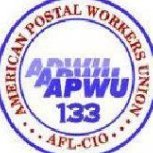
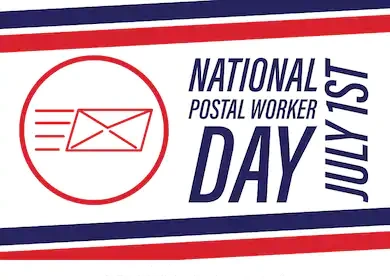
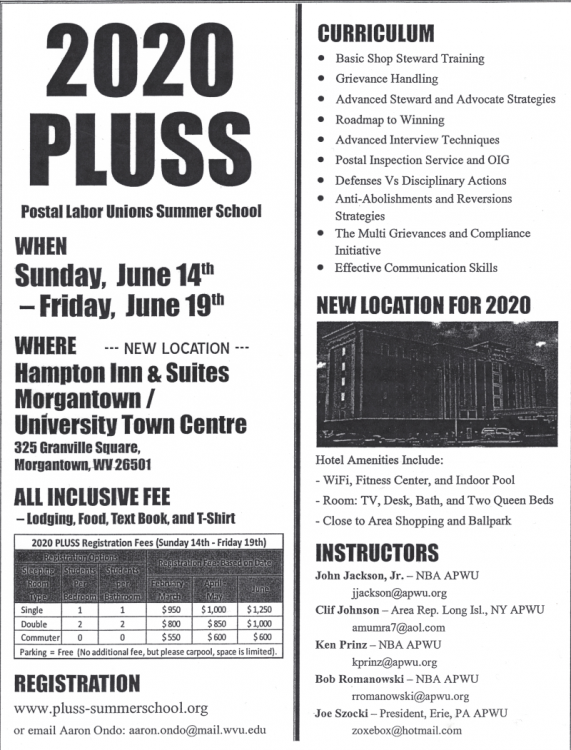
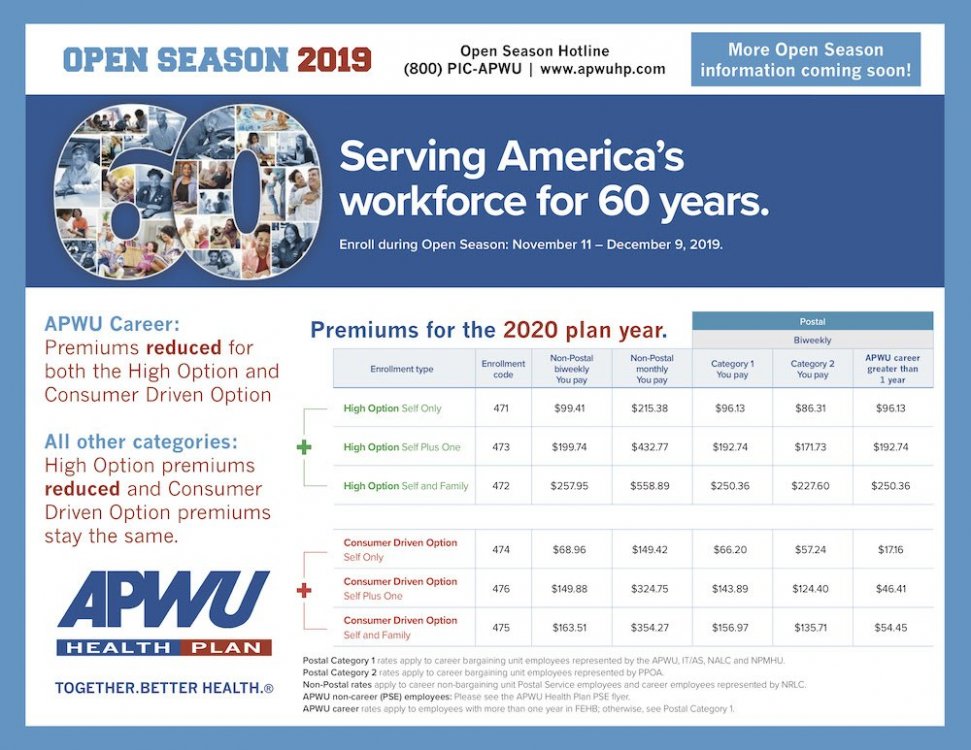
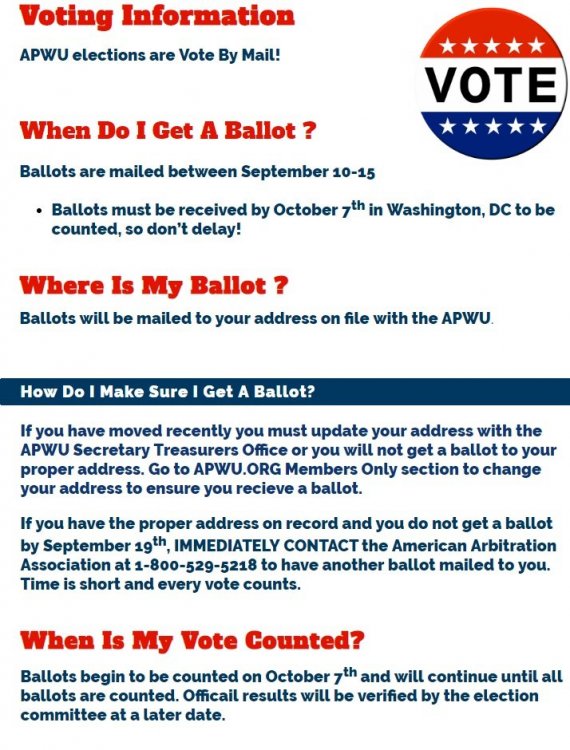
Sign up for the Senate Call in Day of Action
in National News
Posted
Our movement is growing. Together we can save the Post Office and convince lawmakers to do their jobs!
Multiple bills have been introduced in the House and the Senate that would provide $25 billion in COVID-19 related relief for the Postal Service. But the clock is ticking and we mustn't run out of time.
The Senate will return from recess soon. We need to push even harder to get them to vote to end this crisis. We are planning to put in 10,000 calls to Congress on July 23.
Will you join us on this critical call-in day of action??
Sign Up!